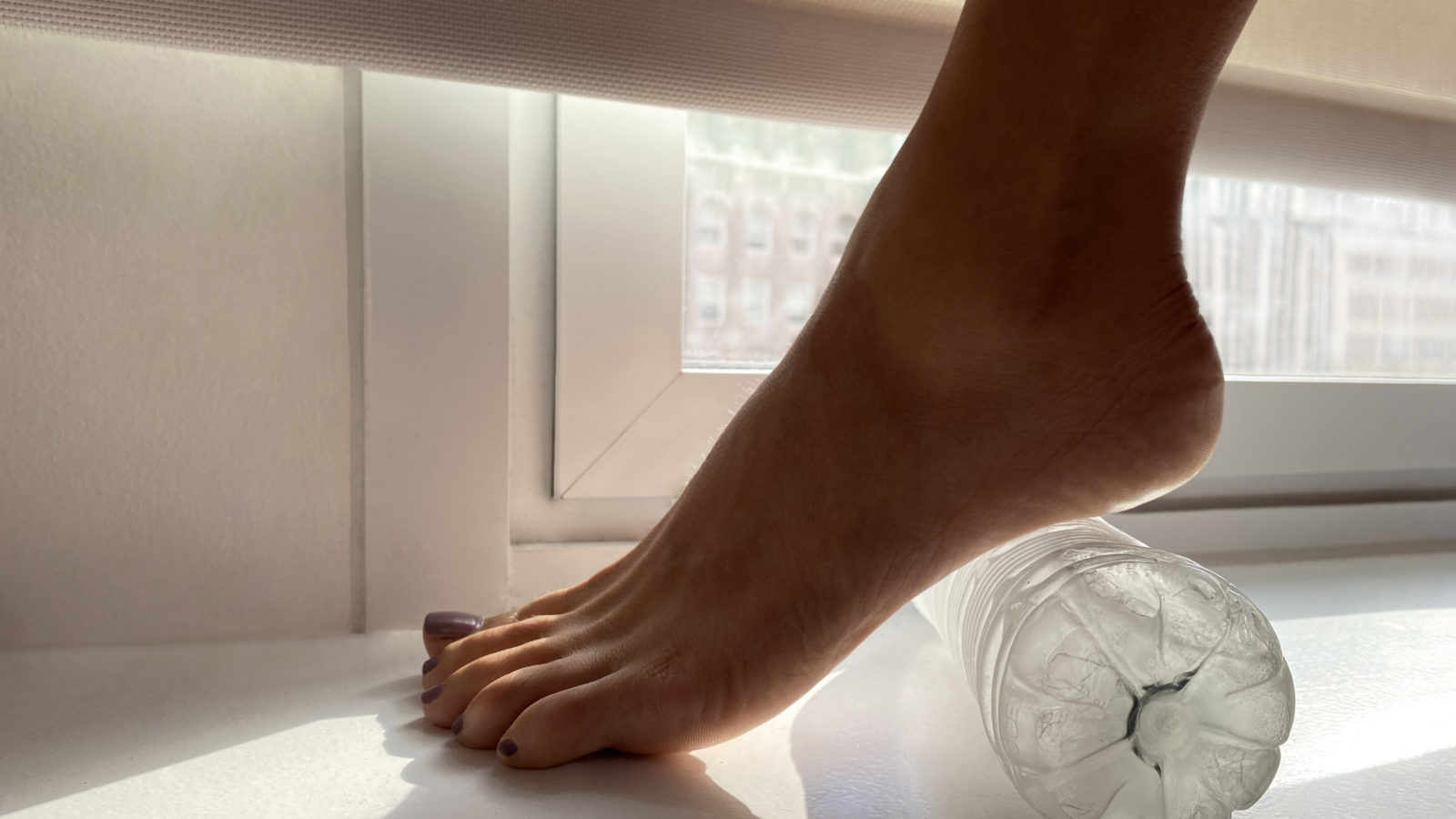Post-pandemic, after months of lockdown-induced barefoot living and Birkenstock- wearing, I slid on my real-world shoes and started walking, thinking I could pick right back up from where I left off. I walked around as much as possible, eager to make up for all the lost time, unfortunately unaware that my extremities were not quite prepared for what I was about to hit them with, ultimately deciding to rebel.
After dismissing the initial warning signs, I was quickly hit with an overload of agony that became impossible to ignore. I experienced shooting pains in my heel, plain and simply leaving me KO, and showing me just how interlinked quality of life is to one’s ability to move freely.
Fortunately, I wound up in the exceptional care of Dr. Rock Positano, Director of Non- Surgical Foot and Ankle Services at the Hospital for Special Surgery of New York. The Italian American doctor, who is also Foot and Ankle Consultant for The New York Mets, helped me get back on my feet, quite literally. Throughout this rehabilitation process, I came to learn that I was not alone in this struggle, as this exact condition shot up 20- 30% post-lockdown. Dr. Positano dubbed this epidemic as the “Pandemic Foot” and is currently completing his studies with the Yale University School of Public Health to quantify the matter properly statistically.
“It’s important to not underestimate the severity of symptoms”, explains Positano, “because problems with our feet, though not life-threatening, can be deleterious to one’s quality of life. The inability to move directly influences one’s ability to exercise, socialize, and consequently can be very taxing emotionally as well. During lockdown, routines and habits were forced to change; people who normally would take public transport shifted to walking, for fear of contagion, moving from 2 to 7 km per day. While this degree of exercise is in fact recommended for regulating blood pressure, circulation, bone health, and glucose levels, those not previously accustomed to this degree of activity quickly suffered adverse effects.”
Furthermore, in spending more time at home, everyone inevitably spent more time barefoot or in slippers than previously accustomed to – but walking with little to no arch support for prolonged periods of time is not recommended. Even just being at home, we traverse a surprising amount of mileage, leading our tendons and ligaments, to work much harder than expected and ultimately beginning to give in. While it’s true cavemen lived their lives barefoot, it’s also true their lifespan only ranged about 20 years, so it’s not quite apples to apples. Protecting one’s feet must not be overlooked, and its functionality should never be taken for granted.
After the lockdown, there began to be a notable rise in heel pain, which serves as the primary point of shock absorption during the repetitive impact whilst walking. A lack of adequate support compromises its ability to properly function, causing a, rather painful, chain reaction. The issue starts with the heel itself suffering from inflammation, then migrating to the plantar fascia, as well as the fatty tissue that surrounds it. Not long thereafter, a series of repercussions will begin to manifest along the entire body, because when one’s feet begin to fail, the body begins to compensate – and the knees, back, and hips are the first to feel it.
“This trend is most certainly on the rise,” Positano elaborates, “independent of one’s age range. We have patients in their 30s with the same probability of developing these issues as those in their 80s. Even athletes, who have had to stop their rigorous training as a result of the pandemic, have displayed signs of this same issue when they picked it back up.” The pandemic certainly didn’t discriminate!
It is vital we all learn to listen to our bodily cues. When your feet start talking to you, make sure you listen! Do not hesitate to find a specialist, especially if the problem persists for longer than 2 weeks. “The correct diagnosis is fundamental in understanding how to intervene with rehabilitative therapies in cases that do not require surgical intervention,” explains Positano, “because 95% of all foot and ankle issues can be resolved without surgery. Other than having long and strenuous recovery periods, surgery oftentimes doesn’t even resolve the issue, and may end up creating more down the line.” This was the case for Joe DiMaggio, notable Italian American baseball player and successful patient (and later, friend) of “Doc” Positano, who worked with him during the last decade of his life. In addition to having written a book about him, titled Dinner With DiMaggio, Positano also dedicated the department Joe DiMaggio Sports Medicine Center of HSS in his honor – the only one in the USA that has been treating these cases for 25 years. The center is frequented by a vast number of patients from across the world; in particular, Switzerland and Italy, sent his way by their specialists. Generally, they are individuals that have been advised to have surgery, trying this as a last resort, almost unanimously successfully.
“Our most successful therapies”, details Positano, “are therapeutic Ultrasound cycles and Extracorporeal Pulse Activation Technology (EPAT). Once out of the acute phase, it is important we focus on properly maintaining the situation – much like we do on our car tires. Then, as soon as we feel the issue returning, containing the inflammation with ice, and intervening promptly before it gets aggravated. Then, continuing to keep an eye on it, without ever letting our guard down. In certain cases, we prescribe orthopedic insoles to properly stabilize the mechanism in the foot, which can be very successful when done properly. Insoles are very delicate, though, and not everyone is able to successfully craft them. We greatly advise against using general or commercially accessible ones. Much of my practice is based around Leonardo da Vinci’s study of the foot, as he analyzed the structure and movement to properly understand the dynamics of this “rigid lever”, capable of creating the propulsive force necessary to walk. A true natural engineering prodigy, whose sole is so individual that, in recognition, is even more reliable than fingerprints.”
As a precaution, observing one’s specific type of foot – normal, flat or with a high arch – immediately reveals the type of pathologies that may develop. “We recommend doing a diagnosis of one’s foot while still young”, suggests Positano, “even before developing any noticeable symptoms, because with time, tendons and ligaments are prone to shifts or may not develop properly. Therefore, properly identifying the potential problem areas before the problem manifests can potentially prevent any worsening conditions. In particular, cases of hallux valgus, if caught in time, can avoid surgery.
Stretching one’s feet before getting out of bed can aid in elongating tendons and increasing elasticity, subsequently increasing mobility. Massages can also help, but not if the patient has existing inflammation, in which case it can actually lead to a worsening of the condition – especially if there is a potential pulled muscle.
The utmost important preventative measure is to wear the correct shoes. This means a 3/5cm heel, which, in addition to encouraging the correct articulation within the foot, protects the knee and Achilles tendon as pressure is applied. Shoes with no elevation whatsoever do the exact opposite. With that said, it is also a matter of where and how shoes are worn. There is no need to eliminate high heels entirely; they can be worn on special occasions when taking a seat is also an option – but walking for extended stretches in them is not advised. Amongst the more high-fashion shoes, Roger Vivier presents a wider, 4cm heel, which is much more comfortable for the foot, allowing sufficient space for the toes.”
Walking all day on these incredibly complex anatomical structures, which are simultaneously incredibly delicate, means they deserve much of our care and attention. Our feet are our roots that both move us and stabilize us, and if they are seen as a mirror of our emotional state, taking care of them also takes care of our internal needs. Often disregarded and even looked down upon, the reality is that our feet are the foundation of the entire body’s well-being. To regain control over the welfare of our feet, essential also to our psychological health, the first step is to begin show them more love.


